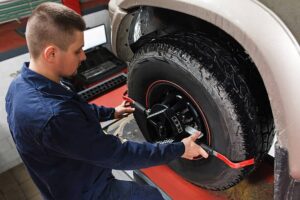If you’re a 4WD driver, you know just how important it is to maintain your vehicle before and after each trip. Dirt, mud, and water can put added pressure on the drivetrain and other components, leading to damage and costly repairs.
Luckily, regular 4WD service Adelaide isn’t that much more expensive than other car services. It can save you time and money in the long run.
Brakes
 The brakes are an extremely important component when you’re driving a 4WD vehicle. Whether crossing a muddy track or trying to avoid an animal, stopping quickly is crucial to your safety.
The brakes are an extremely important component when you’re driving a 4WD vehicle. Whether crossing a muddy track or trying to avoid an animal, stopping quickly is crucial to your safety.
To ensure your vehicle’s brake system is working properly, it’s a good idea to have the fluid changed regularly. The fluid helps to lubricate the braking system and prevent corrosion.
The fluid should also be checked to ensure it’s not too low. It could result in your vehicle squealing or making strange noises when you press down on the brake pedal.
You can check your fluid level by looking for a space in the brake reservoir under your vehicle’s hood. Check the owner’s manual if you’re unsure where this area is.
It’s also a good idea to drive at a safe speed and avoid erratically stopping your vehicle. It can put a lot of strain on your brake pads and rotors and can shorten their lifespan significantly.
It’s a good idea to have your brake pads replaced every 40,000 miles or so. You should also change the transmission fluid and filter as often as possible to avoid problems.
Tires
Your tires are the most important part of your vehicle’s performance. Whether you have an AWD, 4WD or FWD vehicle, keeping them in top condition is crucial to maintaining your safety and the quality of your ride.
Tires must be properly sized and rotated regularly to ensure the best performance. Even a slight difference in size can result in additional strain on the drivetrain.
Regular rotation can also spread wear evenly across all four tires and help improve tread life. Especially when you add new tires to your vehicle, rotating them will maximize the time they’ll last.
It’s also a good idea to rotate your tires at least 5,000 miles to ensure they’re not developing uneven wear. It will keep them uniform in their tread depth, providing consistent traction and handling on all four wheels.
Winter tires are designed to grip the road even when the weather is at its worst. They’re made with softer rubber compounds that remain more pliable in cold temperatures and have tread blocks that dig into snow and spit it back out. They’re also equipped with sipes, which are razor-thin slits in the rubber that become thousands of micro-pumps to deliver traction on ice.
Aside from delivering superior traction in the snow, winter tires are more durable than all-season tires. They can resist cracking, chipping and tearing when exposed to severe cold conditions.
Suspension
If you own a truck, SUV, or any other vehicle with four-wheel drive, then you have a few extra components on your car that require regular service. You’ve got a transfer case, differentials, and a lot of other parts that need to be checked regularly to keep your car running smoothly.
One of the most important aspects of your 4WD is the suspension. This system comprises tires, air, springs, and dampers that connect the wheels to the frame. It is designed to balance road holding and handling with ride quality.
Heavier vehicles and trucks have heavier springs, allowing them to absorb heavy loads without collapsing into the ground. Heavier springs are also needed in performance applications where the loading conditions are higher than normal.
A common design is the Hotchkiss drive, which uses leaf springs attached to both front and rear axles to transmit torque from the engine. These were popular in American cars from the 1930s until the 1970s and have become increasingly rare in recent years as more advanced suspension designs are developed.
Some modern suspensions are semi-active, where an electronic control unit sends signals to the suspension to adjust its functions. Several modern systems employ hydraulic or pneumatic actuators.
There are many different suspensions, each of which has unique nuances. However, most have springs and dampers that absorb impacts and control the vehicle’s motion up and down on its springs.
Transfer Case
The transfer case is an important part of your vehicle’s drivetrain, allowing you to switch between two-wheel and four-wheel drive. A well-maintained transfer case can keep your engine running smoothly and help you avoid serious problems like wheel slip or losing traction on tough terrain.
There are a few different transfer cases, depending on the model of your vehicle. Some offer low-range gears for off-road use, and others have an active 4WD system that does not require driver input to engage or disengage the four-wheel drive.
On the other hand, a full-time transfer case always sends power to the front and rear axles. It is designed to reduce or eliminate bind on hard surfaces such as gravel and mud, and some of them have a high-range differential that can lock in for better traction when the terrain calls for it.
Some of these systems also have a low-range setting that increases torque to the rear axles while decreasing engine speed and fuel economy, which helps you get around on rough roads or through snow or ice. They are usually found on trucks and SUVs.